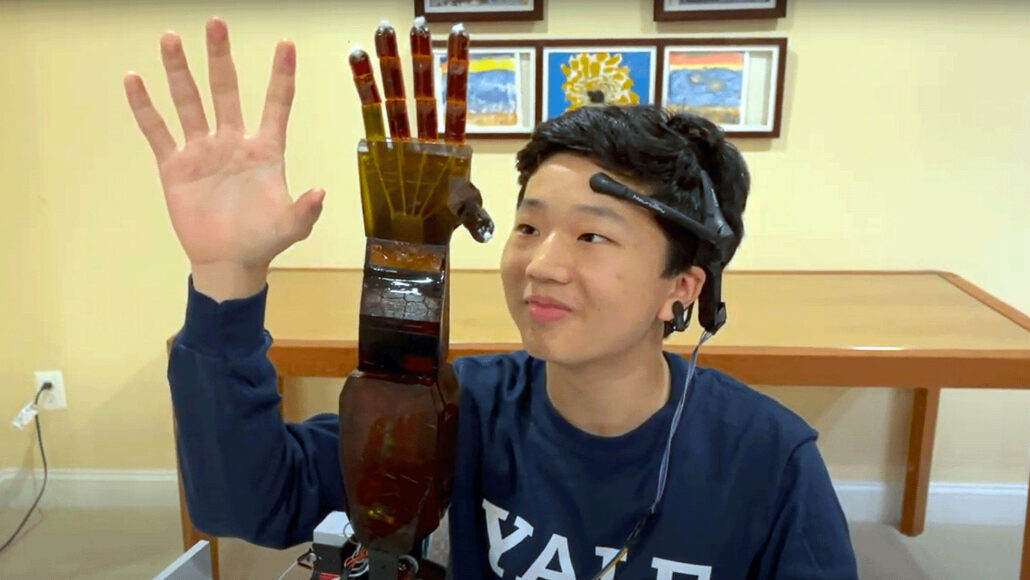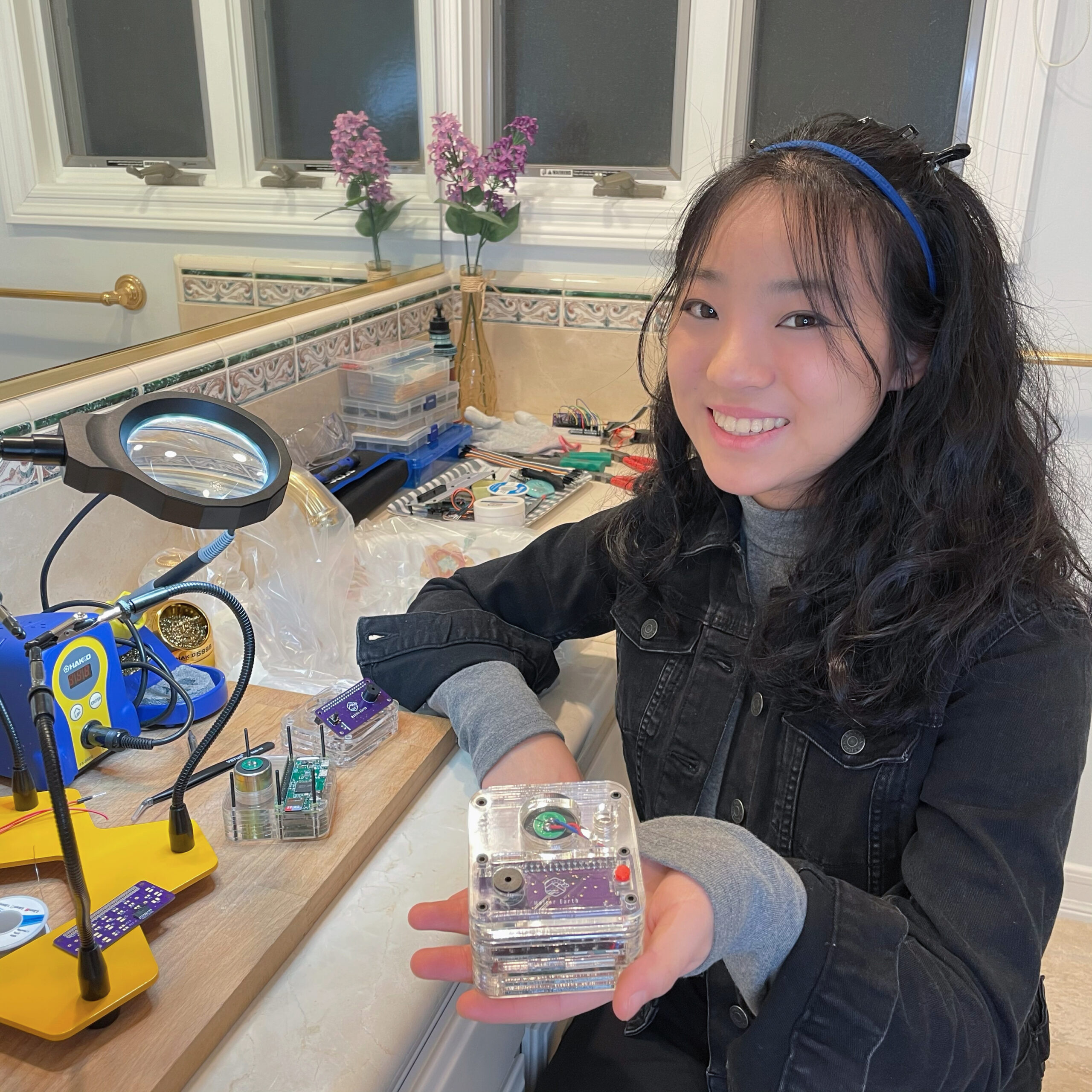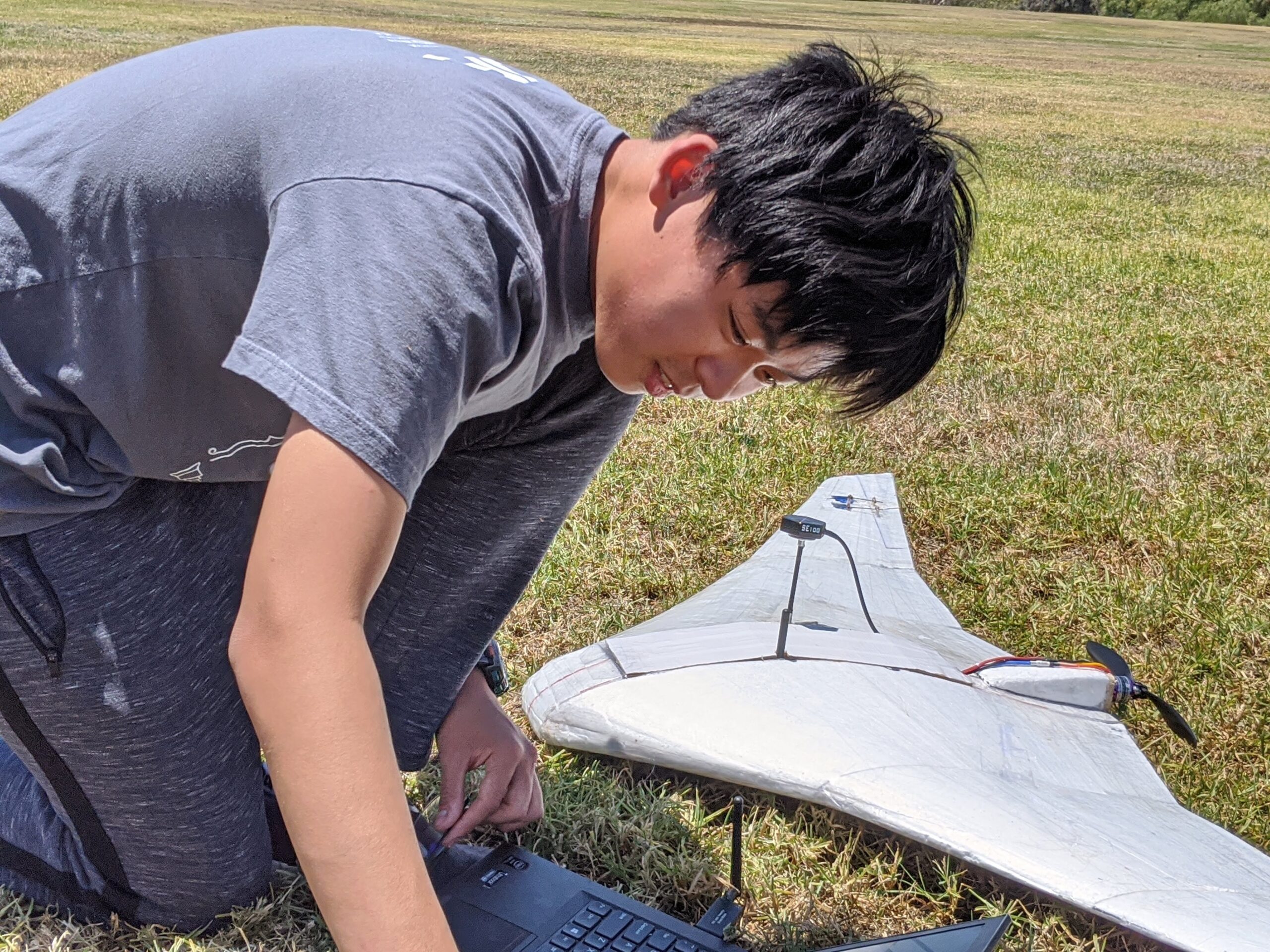Teen inventors say: There’s got to be a better way
Finalists in the 2022 Regeneron Science Talent Search are rethinking existing technologies to work better

High school seniors like Ben Choi, pictured with a mind-controlled robotic arm that he built, competed in this year’s Regeneron Science Talent Search.
Benjamin Choi/YouTube
Fictional inventors are often seen toiling away in big, fancy labs. Tony Stark’s workshop surrounds him with holographic screens. Jimmy Neutron stashes gadgets in a huge underground hideout. Willy Wonka has an entire factory. But real-world innovation doesn’t require such elaborate sets. Just ask the finalists of this year’s Regeneron Science Talent Search.
This annual event is the nation’s premier science and math competition for high-school seniors. It’s run by Society for Science. (Society for Science also publishes Science News for Students.) Each year, 40 finalists compete for more than $1.8 million in prizes — and show off their own feats of science and engineering.
The 2022 lineup includes several young inventors who have turned their basements, bathrooms and garages into workshops. The teens’ homemade tech could improve prostheses, earthquake-warning systems and air travel.
Mind over machine
Ben Choi’s goal is simple: Build machines that can read minds.
When only about eight years old, Ben became fascinated by mind-controlled prostheses. He saw a documentary on these artificial limbs, which are controlled by devices implanted in the brain. “I was really amazed,” recalls the now 17-year-old senior at the Potomac School in McLean, Va. “But it was also pretty alarming.” Implanting the electrodes required risky brain surgery. And those artificial limbs cost hundreds of thousands of dollars.
“They’re really not that accessible,” Ben says. “That always kind of stuck with me.”
In 2020, Ben set out to create his own non-invasive, low-cost bionic arm. He set up shop on a basement ping-pong table. His first prototype was built with a small 3-D printer borrowed from his sister. After updating his design more than 75 times, Ben has now showcased a refined version of the arm using industry-grade resin. It still costs less than $300 to make.
The arm is controlled by electrodes worn on the forehead. Those sensors eavesdrop on the brain’s electrical activity, or brainwaves. Thinking about different arm motions, such as waving or making a fist, creates different brainwave patterns. An artificial intelligence, or AI, system deciphers those brainwaves to move the robotic arm.
The AI system had to be trained to interpret those brainwaves. Ben gathered brainwave data from volunteers at his school and in his family. “From those participants, I collected maybe an hour or two of brainwave activity,” he says. “That’s many thousands of data points.” Studying those data helped the AI system learn to read minds.
In early tests, Ben’s robotic arm has proved about as nimble as the world’s best brain-controlled prostheses, he says. Those results need to be confirmed in a clinical trial. But if they hold up, this bionic arm could be a game-changer for prosthetic tech. And why stop at bionic arms? Similar AI systems could someday control mind-reading wheelchairs or other devices.
Personal earthquake detectors
The inspiration for Vivien He’s invention hit closer to home. She’s a senior at Palos Verdes Peninsula High School in Rolling Hills Estates, Calif. Growing up in Southern California, this 18-year-old has spent a lot of time huddling under her school desk during earthquake drills. These ground tremors are the world’s deadliest natural disasters. And they’re unpredictable.
Earthquake early warning systems do exist. One is the ShakeAlert system on the U.S. West Coast. Seismic stations in the ShakeAlert network detect ground vibrations when a quake strikes. Those stations then alert people that the ground under them may soon start to rumble. But it’s hard to predict how much the ground will shake at any given place. And people closest to an earthquake’s source are out of luck. They’ll feel the shaking before they can get an alert.
To give people a better read on the ground beneath their feet, Vivien built an at-home earthquake sensor. “I like to compare it to a smoke detector, but for earthquakes,” she says. Called the Qube, this device uses a motion sensor called a geophone to feel mild tremors that may mark the beginning of a bigger quake. Then, it can warn users by sounding an alarm or sending text alerts.

About the size of a Rubik’s cube, the Qube costs less than $100 to make. To build it, Vivien bought a soldering machine and watched YouTube videos to learn how to use it. Then she went to work in a spare bathroom. “I’ve always been a very hands-on person,” she says. She found it fun to assemble each new Qube — often with an old movie playing in the background.
During nine months of testing, Vivien’s Qube detected all earthquakes over magnitude 3 around Los Angeles. The motion data captured by her Qube also matched those from a nearby seismometer in the Southern California Seismic Network. Vivien shared those results in December in Seismological Research Letters.
Vivien is now building up a network of Qubes around Los Angeles. “I have eight devices in different homes,” she says. A widespread Qube network could serve a similar role as ShakeAlert seismic stations. When one Qube starts to shake, it could alert users across town of an oncoming quake. But unlike seismic stations, Qubes are tiny and inexpensive. So, many more of them could be installed around a city.
The ultimate goal is to create such a low-cost seismic network in low-income areas that may be more vulnerable to quakes, Vivien says. “I want to be able to place a network like what I’m building now in those kinds of communities across the world.”
Reinventing the wing
Like Ben and Vivien, 17-year-old Ethan Wong is revamping existing technology. His focus: airplanes.
Nearly all planes have a tail. The tail keeps the plane’s nose from swerving during a turn. The structure adds stability but weighs the plane down. Specially designed airplane wings could serve the same function as the tail. This could boost flight efficiency and cut the environmental cost of air travel. But there’s a catch. Those wings must twist in a very precise way that makes them hard to manufacture.
Ethan became fascinated by this kind of airplane design when he saw a video of NASA’s Prandtl-D aircraft gliding gracefully through the air without a tail. “I just thought that was really cool,” says Ethan. He’s a senior at Arcadia High School in California. Ethan builds model airplanes for fun. He wondered if he could find a simpler way to achieve the same tailless flight.

“Essentially what I did was just trial and error,” Ethan says. Using a computer model of an airplane wing, he tweaked the angle of twist along the wing until it could achieve tailless flight. Usually, such a wing “requires a continuous distribution of wing twist,” Ethan says. But he could achieve a similar effect with wings that had just a few sections of twist. “It’s super easy to make.”
In his garage, Ethan built model airplanes using foam and packing tape to test his design. “Seeing the plane in the air, that was pretty cool,” Ethan says. “It just flew really, really well.”
Lighter, more efficient planes could open the door to other air travel innovations. “It’s been a long-term goal of mine to build a solar plane that can fly through the day powered by solar panels on its wings,” Ethan says. “It is absolutely possible for a really efficient plane.”
To other teens who have big engineering ideas they want to explore, Ethan has one word: persistence. “Don’t ever give up,” he says. Even when some machinery feels impossible to understand, it helps to remember that the world’s greatest inventors were only human, too. “Also, just make sure you love whatever you do,” Ethan adds. “That’ll make pursuing everything a lot easier.”
Cosmic researcher wins big
At a gala ceremony last night, Christine Ye, 17, won first place — and $250,000 — at this year’s Regeneron Science Talent Search competition. The teen, who hails from Sammamish, Wash., studied gravitational waves emitted in powerful collisions between neutron stars (collapsed super-dense stars) and black holes. Christine analyzed data collected by the Laser Interferometer Gravitational-wave Observatory (LIGO) to model rapidly-rotating neutron stars. She showed that a fast-spinning neutron star could be super massive, yet would still be smaller than a black hole.
Second-place winner Victor Cai, of Orefield, Pa., will take home $175,000. The 18-year-old created a short-range, narrow-bandwidth radar that is accurate to within 12 centimeters (4.7 inches). Victor hopes such technology can lower the bandwidth needs for self-driving cars so that roads can accommodate more of them.
Third place and $150,000 went to Amber Luo, 18, of Stony Brook, N.Y. She developed a computer program (RiboBayes) to look at how disease can change key regions in a single strand of RNA — sites that control the production of cellular proteins. Amber hopes her research might aid scientists in better understanding what underlies such conditions as Alzheimer’s disease and cancer.
Seven other high school seniors took home between $40,000 and $100,000. The remaining 30 finalists each received $25,000. Watch videos to see each of the top 10 winners describe their research and its implications.







